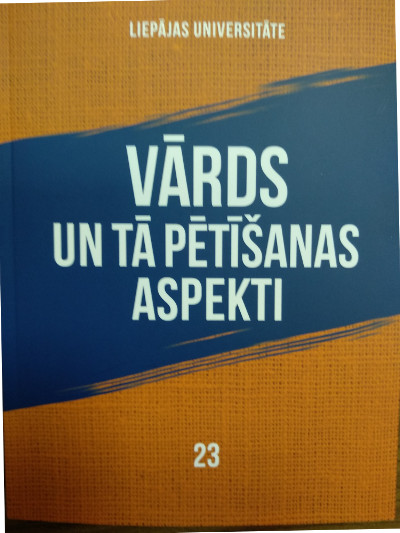

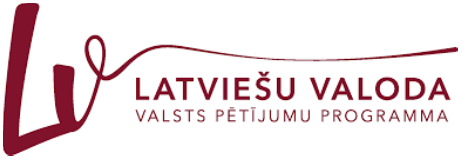
Liepāja University
Faculty of Humanities and Arts
and
Kurzeme Institute of Humanities
invite you to participate in
the 28th International Scientific Conference
which will be held at Liepāja University
23 November–24 November 2023
|
SATURS Ievadvārdi Preface I daļa Leksikas un stilistikas jautājumi. Valodas prasme Vārda diahroniskais un areālais aspekts |
7 9 |
|
Anna Frīdenberga Vārdi zagt un zaglis senajos latviešu rakstu avotos The Words zaglis and zaglis in the Early Latvian Written Sources |
12 |
|
Anita Helviga Mūsdienu latviešu terminogrāfijas raksturojums: vārdšķiriskais aspekts Characterisation of Contemporary Latvian Terminography: The Part of Speech Aspect |
23 |
|
Linda Lauze, Kristīne Mežapuķe Literārās valodas un sarunvalodas attiecības: sociālo mediju piemērs The Relationship Between Standard Language and Colloquial Speech: Case of Social Media |
37 |
|
Evija Liparte Par dažām vakcīnas pret Covid-19 apzīmēšanai lietotajām metaforām On Some of the Metaphors Used to Brand the Covid-19 Vaccine |
48 |
|
Daiga Straupeniece, Normunds Dzintars Skolēnu rakstu valoda latviešu valodas un vēstures valsts pārbaudes darbos 2021. gadā Kurzemē Pupils’ Written Language in the Latvian Language and History State Examinations in Kurzeme in 2021 |
61 |
|
Aleksejs Šņitņikovs, Jūlija Svitaja Word, Text and Reading in the Digital Age Vārds, teksts un lasīšana digitālajā laikmetā |
72 |
|
Ilze Štrausa No Abelardo līdz Azazello jeb kaķu vārdi ar sākumburtu A From Abelardo to Azazello or Cat Names with the First Letter A |
82 |
|
Viktorija Tataurova, Jekaterina Martinova Distance, Remote, Virtual, Blended, Hybrid and Online Learning: Selecting the Proper Name for Modern Realia Tālmācība, attālinātās, virtuālās, jauktās, hibrīdās un tiešsaistes mācības: piemērota nosaukuma izvēle mūsdienu reālijām |
92 |
|
II daļa Valoda un vide Fonētikas, semantikas un gramatikas jautājumi Vārda sinhroniskais un areālais aspekts |
|
|
Ieva Auziņa Par dažu bezpriedēkļa un priedēkļa verbu lietojumu ar adverbiem un prievārdu pār About Some Unprefixed and Prefixed Verb Connections with Adverbs and the Preposition pār |
108 |
|
Ina Druviete Karš Ukrainā: migrācijas ietekme uz Latvijas valodas politiku War in Ukraine: Impact of Migration on Language Policy in Latvia |
115 |
|
Agute Klints, Madara Stāde, Lauma Pretkalniņa, Laura Rituma Lingvistiskais eksperiments: marķētāju vienprātība latviešu valodas WordNet semantisko saišu veidošanā Linguistic Experiment: Inter-Annotator Agreement in the Semantic Linking of Latvian WordNet |
125 |
|
Sintija Ķauķīte Pieturzīmes interneta forumos Punctuation Marks in Internet Forums |
139 |
|
Dite Liepa, Velga Polinska Vietnes mammadaba.lv tulkojums vieglajā valodā: leksikas analīze Translation of the Website mammadaba.lv in the Easy Language: Lexical Analysis |
150 |
|
Anete Ozola Ģenitīva prievārdu rekcijas īpatnības lībiskā dialekta Kurzemes izloksnēs Genitive Preposition Government Peculiarities in Kurzeme Livonic Subdialects |
162 |
|
Anete Ozola Ģenitīva prievārdu rekcijas īpatnības lībiskā dialekta Kurzemes izloksnēs Genitive Preposition Government Peculiarities in Kurzeme Livonic Subdialects |
162 |
|
Anete Ozola Ģenitīva prievārdu rekcijas īpatnības lībiskā dialekta Kurzemes izloksnēs Genitive Preposition Government Peculiarities in Kurzeme Livonic Subdialects |
162 |
|
Ieva Ozola Vienojuma, pretstata un šķīruma saikļi Lejaskurzemes izloksnēs Cumulative, Adversative, and Disjunctive Conjunctions in Subdialects of Lower Kurzeme |
173 |
|
Guna Rābante-Buša Partikulas kaut izrunas varianti Pronunciation Variations of the Particle kaut |
184 |
|
Ziņas par autoriem / About the Authors |
192 |
Preface
The 27th issue of the annual collection of articles of Liepāja University, “The Word: Aspects of Research”, has reached its readers. The collection offers an insight into the research and problems of various fields of linguistics, also addressing conceptual issues and focusing on today’s characteristic phenomena related to the development of technology and events in the world.
In the 1st part of the collection of articles, you can get acquainted with studies in the field of lexis and stylistics, both in the synchronic and diachronic aspects.
Anna Frīdenberga continues to study the history of lexis, examining the words zagt and zaglis in the early Latvian written sources. In the field of onomastics, Ilze Štrausa offers a study on cat names and describes the motivation behind the choice of cat names that begin with the letter A.
The problems of terminology and terminography are studied in two articles. In their joint article, Viktorija Tataurova and Jekaterina Martinova explore the names of different learning methods, their conceptual understanding and advantages and disadvantages from the students’ point of view. Anita Helviga focuses on the principles of creating term dictionaries and analyses the word class aspect in modern Latvian terminography.
In several articles, stylistic issues of the Latvian language are discussed. Evija Liparte has continued her research on the language of the Covid-19 pandemic in Latvian public space and writes about positive and negative connotation metaphors used to characterise vaccines against the virus. The joint article by Linda Lauze and Kristīne Mežapuķe analyses the attitudes between literary and colloquial language in Latvian social media.
Daiga Straupeniece and Normunds Dzintars focus on the language skills of the new generation – their joint article analyses the mistakes made by students in the centralised examinations in the Latvian language and history. The issue of language skills is closely related to reading habits, the change of which has been studied by Aleksejs Šņitņikovs and Jūlija Svitaja.
The articles of the 2nd part of the collection are devoted to topical issues of linguistics in the areal and synchronic aspects.
The interaction between language and environment is discussed in two articles. Ina Druviete has analysed how migration caused by the war in Ukraine affects the language policy in Latvia. In the joint article of Dita Liepa and Velga Polinska, the translation in easy language has been discussed in terms of vocabulary based on examples on the website mammadaba.lv. Phonetics research is represented by Guna Rābante-Buša, who has described the pronunciation variants of the particle kaut, while semantics is represented by the joint paper of Agute Klints, Madara Stāde, Lauma Pretkalniņa and Laura Rituma, which is dedicated to a linguistic experiment in order to find out the inner-annotator agreement in the formation of semantic links. Grammatical issues have been discussed the most extensively. Areal research – peculiarities of the government of genitive prepositions in the Kurzeme Livonic subdialect (Anete Ozola) and coordinating conjunctions in Lower Kurzeme subdialects (Ieva Ozola). Synchronic studies – the use of some verbs with adverbs and the preposition pār (Ieva Auziņa) and the use of punctuation marks in internet forums (Sintija Ķauķīte). Articles of 13 authors or co-authors have been developed in the projects of the state research programme “Letonika – Fostering Latvian and European Society”, mostly in the project “Use and Development of Modern Latvian” (eight authors). The research of nine authors was carried out in other projects.
The collection of scientific articles, “The Word: Aspects of Research”, is included in the EBSCO database; information on the collection and published articles are available at the Latvian National Digital Library. All the articles have a DOI index.
May every reader discover something new in the wide field of aspects of the word research!
Linda Lauze, Sigita Ignatjeva,
Editor-in-Chief and Deputy Editor
of scientific articles’ collection
“The Word: Aspects of Research”
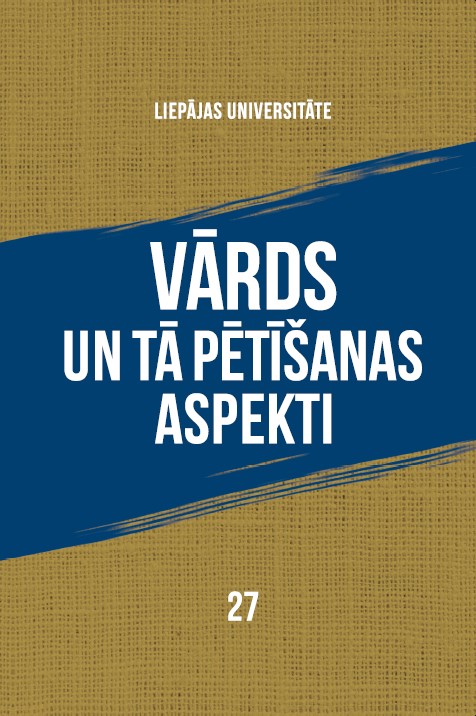
|
SATURS Ievadvārdi Preface I daļa Gramatika, leksika, stilistika Vārda diahroniskais un areālais aspekts |
9 12 |
|
Ieva Auziņa Dažu konstrukciju bezpriedēkļa verbs + adverbs un priedēkļa verbs + adverbs lietojums latviešu valodā About Usage of Some Latvian Constructions Involving Unprefixed Verb and Prefixed Verb and an Adverb |
16 |
|
Anete Daina Darbības vārdi varēt, drīkstēt un valodas ietekmējošā funkcija Latvijas Republikas Saeimas 2018. gada sēžu stenogrammās Verbs varēt, drīkstēt and Conative Function of Language in the Corpus of the Saeima of the Republic of Latvia (2018) |
24 |
|
Anna Frīdenberga Vārdi zīme, zīmēt, zīmot senajos latviešu rakstu avotos The Words zīme, zīmēt, zīmot in the Early Latvian Written Sources |
36 |
|
Sigita Ignatjeva Valoda Artura Heniņa vēsturiskajos romānos: teksta arhaizācija un stilizācija Language in the Historical Novels by Arturs Heniņš: Archaization and Stylization of the Text |
48 |
|
Dalia Jakaitė Malda kaip žodis ir veiksmas Gražinos Cieškaitės, Skaistės Vilimaitės ir Lauros Sintijos Černiauskaitės poezijoje Prayer as a Word and Action in the Poetry of Gražina Cieškaitė, Skaistė Vilimaitė and Laura Sintija Černiauskaitė |
58 |
|
Ilga Jansone Priekšvārdi Ilzenes muižā 1826. gada Vidzemes dvēseļu revīzijas materiālos Forenames in Ilzene in Vidzeme Soul Revision Materials from 1826 |
68 |
|
Sintija Ķauķīte Pieturzīmes emuāros Punctuation Marks in Blogs |
82 |
|
Evija Liparte Par luksofora krāsu nosaukumu polisēmijas paplašināšanos Covid-19 pandēmijas laikā Polysemantic Extensions of Names for Colours in Traffic Lights During the Covid-19 Pandemic |
93 |
|
Ieva Ozola Tagadnes pasīvo divdabju substantivēšanās: dialektālo vārdnīcu dotumi Substantivization of Present Passive Participles: Data in Dialectal Dictionaries |
107 |
|
Edita Puskunigytė Eroso trauma Vitalijos Pilipauskaitės-Butkienės ir Tomo Petrulio poezijoje The Trauma of Eros in the Poetry of Vitalija Pilipauskaitė-Butkienė and Tomas Petrulis Erosa trauma Vitālijas Pilipauskaites-Butkienes un Toma Petruļa dzejā |
117 |
|
Ilze Rudzāte Latviešu valodas tautas celtniecības leksika Baltijas jūras piekrastē Latvijā un Lietuvā: reālijas jumts un tā daļu nosaukumi Latvian Folk Construction Vocabulary at the Baltic Sea Coast in Latvia and Lithuania: Designations of the Object Roof and its Parts |
124 |
|
Daiga Straupeniece Substantīvu piedēkļu -el- un -ēn- lietojums Būtiņģes un Sventājas latviešu valodā The Use of Substantives’ Suffixes -el- and -ēn- in the Latvian Language of Būtingė and Šventoji |
135 |
|
Ilze Štrausa Dzīvnieku sugu nosaukumi kaķu vārdos Names of Animal Species in Cat Names |
145 |
|
Agris Timuška Leksēma tēvs Eiropas valodu izloksnēs: ģeolingvistisks pārskats Lexeme Father in Dialects of European Languages: A Geolinguistic Survey |
153 |
|
Domantė Vaišvylaitė Mitai Algirdo Landsbgerio poezijoje Myths in Algirdas Landsbergis’ Poetry |
160 |
|
Rasuolė Vladarskienė Spalvų reikšmės lietuvių administracinėje kalboje Meanings of Colours in Lithuanian Administrative Language Krāsu nozīmes lietuviešu administratīvajā valodā |
170 |
|
II daļa Valoda un vide, terminoloģija, tulkošanas jautājumi Vārda sinhroniskais aspekts |
|
|
Agita Baltgalve Jēdziens sjao sji 消息 (samazināšanās un pieaugšana) ķīniešu klasiskajā filozofijā un tradicionālajā literatūrā The Concept of xiao xi 消息 (Decrease and Increase) in Chinese Classical Philosophy and Traditional Literature |
182 |
|
Ina Druviete Lingvistiskās attieksmes izpausmes ārkārtējās epidemioloģiskās situācijas apstākļos (2020–2022) Latvian Language Attitudes During the Extraordinary Epidemic Situation (2020–2022) |
199 |
|
Agnese Dubova Rekurence kā teksta saistījuma līdzeklis latviešu zinātniskajos rakstos Recurrence as a Cohesive Device in Scientific Articles in Latvian |
211 |
|
Jūlija Gabranova Poļu izcelsmes vārdi Latvijas baltkrievu presē 20. gs. sākumā Words of Polish Origin in the Latvian Belarusian Press at the Beginning of the 20th Century |
219 |
|
Anita Helviga, Diāna Laiveniece Galvenie problēmjautājumi projekta pētījuma „Izglītības terminu skaidrojošā tiešsaistes vārdnīca” īstenošanas sākumposmā The Main Problematic Issues in the Early Stages of Implementing the Project Research “Explanatory Online Dictionary of Educational Terms” |
225 |
|
Aiga Jansone Neapstrādāta mašīntulkojuma izmantošana Use of Raw Machine Translation |
236 |
|
Diāna Laiveniece Zinātniskā raksta nobeiguma daļa: saturs, struktūra, valoda Conclusion Part of the Scientific Article: Content, Structure, Language |
247 |
|
Dzintra Lele-Rozentāle Konektoru lietojums latviešu zinātniskajos rakstos Use of Connectors in Latvian Scientific Articles |
256 |
|
Inta Līsmane, Ilze Ruža Komunikācijas barjeru pārvarēšana mūsdienu studiju procesā Overcoming Communication Barriers in the Modern Study Process |
266 |
|
Александра Ляучук Mодели перевода фразеологизмов: аспекты дефицита Models for Translation of Idioms: Aspects of Deficit Frazeoloģismu tulkošanas modeļi: deficīta aspekti |
277 |
|
Valda Rudziša Kultūras elementu atšķirības dažādās tiesību sistēmās un ar tām saistītās tulkošanas problēmas Differences Between Cultural Elements in Different Legal Systems and Related Translation Problems |
290 |
|
Jānis Sīlis Tradicionālie pētījumu virzieni Latvijas tulkojumzinātnē (2015–2020) Traditional Directions in Latvian Translation Studies (2015–2020) |
297 |
|
Viktorija Tataurova, Diāna Ivanova The Role of Youtube in the Development of the Linguistic Competence of the Students Youtube loma studentu valodas kompetences attīstībā |
306 |
|
Ziņas par autoriem / About the Authors |
321 |
Preface
For the 26th time already, everybody interested in words both in contemporary language and from a historical perspective can acquaint themselves with the annual issue of Liepāja University scientific articles’ collection “The Word: Aspects of Research”. The authors of the articles are teachers from multiple Latvian higher education institutions, employees of other scientific institutions, and researchers from Lithuania. The issue is divided into two parts according to the aspects of research. The articles are written in Latvian, Lithuanian, English, and Russian.
In Part I, readers will find research in diachronic and areal linguistics.
In several articles, a common trait can be observed: contacts of languages and the comparison of different dialects and subdialects have been researched diachronically, establishing similarities and differences. Ilga Jansone has investigated the traces of contacts of Latvian and Southern Estonian languages in the article on forenames registered in Ilzene manor in 1826. Ilze Rudzāte provides a view into Latvian folk construction vocabulary, the names of the building’s roof and its parts in the lexis of three Latvian communities, Latvians of Kurzeme, Latvians of Palanga or on the border with Lithuania, and Latvians of Curonian split or Kursenieki. Daiga Straupeniece’s article is also dedicated to the Latvian language on the Lithuanian border; it deals with the dynamics of some word-formation suffixes in the Latvian language of Būtingė and Šventoji, noticing the common traits with Lower Kurzeme subdialects and emphasising the features and quantitative indicators which are different. Ieva Ozola has studied similarities and differences in the substantivization of present passive participles in two Latvian dialects. The dictionary of Vainiži subdialect (Vidzeme Livonian subdialect) and the dictionary of Nīca subdialect (a Curonian subdialect of the Middle dialect) have been used. The article by Agris Timuška provides a geolinguistic survey on the initial motivation and dialectal variants of the lexeme tēvs by using the maps and commentaries of Atlas Linguarum Europae.
The fields of history of lexis and semantics are covered in Anna Frīdenberga’s research on the semantic diversity of the word zīme and its derivatives in the 16th and 17th-century Latvian written sources.
Synchronic studies of Part I investigate issues related to lexis and semantics. Anete Daina’s research examines Latvian modal verbs varēt and drīkstēt and their ability to perform the conative function of language. Evija Liparte has studied the names for colours in traffic lights (red, yellow, green) which during the COVID-19 pandemic have acquired several new secondary meanings not contained in general dictionaries. Lithuanian linguist Rasuolė Vladarskienė deals with a similar issue. In her article, we can look into the color labels used in figurative meaning in the Lithuanian administrative language and established there under the influence of other languages.
Several authors have researched the use of the word in poetry and novels. The topics are diverse and largely different: prayer as a poetic manifestation of word and action in the works of three contemporary Lithuanian poets (Dalia Jakaitė), the link between eros and trauma characteristic to contemporary Lithuanian poetry (Edita Puskunigytė), mythological characters in the poetry of Algirdas Landsbergis (Domantė Vaišvilaitė), archaisms in the prose language of Arturs Heniņš (Sigita Ignatjeva).
Ilze Štrausa has continued to study the motivation for choosing cat names in the socio-onomastic aspect by analysing the cat names derived from names of different animal species. There are various reasons for such a choice, but Latvians’ close relationship with nature is undeniable.
Lexis and grammar come into contact in Ieva Auziņa’s study on the usage and interaction of some Latvian constructions involving unprefixed verb or prefixed verb and an adverb and the lexical meanings of the verbs and adverbs in such constructions.
Sintija Ķauķīte’s study examines the use of punctuation marks in blogs by Latvian authors.
Part II of the collection contains articles about synchronic research on various current issues in linguistics.
The most attention has been paid to the interaction between language and environment, and several areas have been studied. In sociolinguistics, Ina Druviete has investigated one of the keystones of linguistic situation, language attitudes, during the extraordinary epidemic situation. Scientific language is essential in the academic environment, and it has been examined from the text-formation perspective by characterizing recurrence (Agnese Dubova), use of connectors (Dzintra Lele-Rozentāle) and the conclusion part of the scientific article (Diāna Laiveniece). Some authors have dealt with other languages. Agita Baltgalve provides an immersion into the understanding of the concept of sjao si in Chinese, and Jūlija Gabranova studies language contacts, particularly words of Polish origin in the Latvian Belarusian press. The issues of language acquisition have been discussed in two articles by accentuating overcoming the communication barriers (Inta Līsmane, Ilze Ruža) and the development of linguistic competence through using Youtube (Viktorija Tataurova, Diāna Ivanova).
In this collection, the article by Anita Helviga un Diāna Laiveniece represents the area of terminology. The article deals with the problematic issues that had arisen in the early stages of developing an explanatory online dictionary of educational terms.
Several articles are devoted to the issues in translation. Jānis Sīlis provides an overview of traditional directions in Latvian translation studies (2015–2020). Aiga Jansone characterises the use of raw machine translation, and Aleksandra Ļaučuka examines the models for idiom translation. In the article by Valda Rudziša, translational problems related to cultural elements in different legal systems have been investigated.
The collection of scientific articles, “The Word: Aspects of Research”, is included in the EBSCO database; information on the collection and published articles are available at the Latvian National Digital Library. All the articles have a DOI index.
Wishing a valuable immersion into the topics of linguistics,
Linda Lauze,
Editor-in-Chief
Gunta Smiltniece,
Deputy Editor
of scientific articles’ collection
“The Word: Aspects of Research”
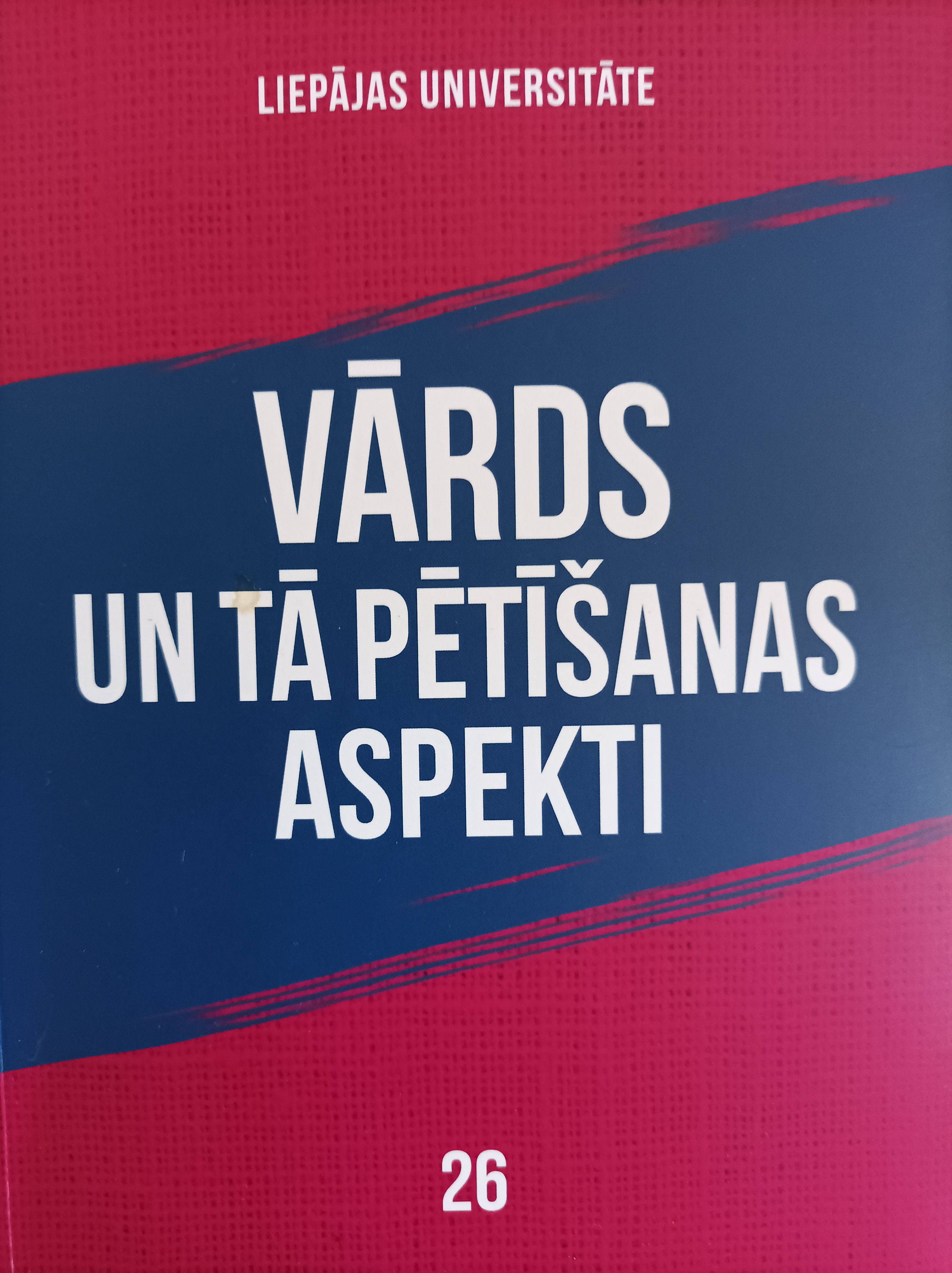
|
SATURS Preface I daļa Gramatika, leksika, stilistika Vārda diahroniskais un areālais aspekts |
9 11 |
|
Māris Baltiņš Latvian Literary Society and Collection of Neologisms and Less Known Words (1874) of Teacher Pēteris Zēvalds |
14 |
|
Brigita Bušmane Insight Into the Names of Porridge Attested in Regional Subdialects of Latvian |
23 |
|
Anete Daina Numerals in Ērģeme Subdialect and its Surroundings |
34 |
|
Аgnese Dubova Die Textbausteine der Einleitung des wissenschaftlichen Artikels und deren Formulierungen |
40 |
|
Anna Frīdenberga Word-Formation Nest with the Basic Word gādāt in the Early Latvian Written Sources |
49 |
|
Iveta Kopankina, Artūrs Viļums Deictic, Prospective and Retrospective Constructions in the Latvian Language of Science |
63 |
|
Karīna Krieviņa Personal Names on Tombstones Inscriptions of the Verbeļi Cemetery in Nīca Municipality |
71 |
|
Sintija Ķauķīte Punctuation Marks in Early Written Latvian Texts |
83 |
|
Dite Liepa, Kristīne Mežapuķe Overview of TV Journalists’ Language Usage (2019–2020) |
94 |
|
Evija Liparte Mājsēde, skorbuļēra, tišmājis, sejauts und andere: Einblick in die Substantivkomposita des Jahres 2020 |
107 |
|
Ilga Migla Einige Ethnonyme in den Phraseologismen der lettischen Sprache |
119 |
|
Ieva Ozola Geschrieben in Mundart: Texte der niederkurländischen Mundarten |
127 |
|
Anna Stafecka The no-Stems of Verbs in Latvian Dialects |
137 |
|
Ilze Štrausa Insight into the Motivation of Choosing Cat Names |
147 |
|
Agris Timuška Apple of Paradise and Its Cognates in Dialects of European Languages: A Geolinguistic Survey |
157 |
|
Jānis Valdmanis Laimdots Ceplītis – an Important Personality in Latvian Linguistics |
162 |
|
Daira Vēvere The Parallels of the Linguistic Features in the Curonian and Tamian Subdialects |
171 |
|
II daļa Vārda sinhroniskais aspekts |
|
|
Līga Beļicka, Ruta Svētiņa Use of Online Lexicographic Tools for the Promotion of Academic Skills in the Course of English for Specific Purposes |
182 |
|
Olga Billere Proverbs and Sayings: Differences and Similarities |
191 |
|
Baiba Egle The Case of the Rucava Brioche: Aspects of Interpreting and Written Text Production |
200 |
|
Eglė Gabrėnaitė, Domantė Vaišvylaitė Pandemijos retorika: argumentavimo strategijos socialinio tinklo „Facebook“ komentaruose |
210 |
|
Linda Gaile Die Bedeutung der Redekorpora in der Erforschung der zielsprachlichen Verdolmetschung The Importance of the Speech Corpus in the Research of Simultaneous Interpreting in the Target Language |
224 |
|
Andrejs Gorbunovs Children Rights Discourse in United Kingdom
|
236 |
|
Sigita Ignatjeva Scientific Language in Joycean Studies |
244 |
|
Nedas Jurgaitis Zur Entstehung und Entwicklung des begriffes „Konzept“ in der kognitiven Semantik Origins and Evolution of the Notion “Concept” in Cognitive Semantics |
251 |
|
Inga Kaija, Daiva Puškorjute-Riduliene Verbs būt and būti in Acquisition of the Second Baltic Language |
260 |
|
Regīna Kvašīte, Kazimiers Župerka Names of Villagers in the Lithuanian and Latvian Languages |
267 |
|
Diāna Laiveniece First Sentence: The Announcement of a Scientific Article |
281 |
|
Dzintra Lele-Rozentāle, Baiba Egle Globalisierung, regionale Spezifik und Sprachengebrauch in wissenschaftlichen Artikeln |
292 |
|
Diāna Liepa Foreign Language Studies: In Search of a Common Approach |
302 |
|
Nijolė Litevkienė Anatomical Terms in Jurgis Žilinskas’ Short Textbook of Osteology and Syndesmology |
315 |
|
Olena Materynska Anthropozentrische Darstellung und Rezeption des Krieges im Deutschen und Ukrainischen |
323 |
|
Līga Romāne-Kalniņa The Linguistic Profile of the Speeches of the President of Latvia Egils Levits: Ceremonial, Judicial, or Political Rhetoric?
|
333 |
|
Dzintra Šulce, Dana Tihomirova Quotes in Scientific Texts and Comments Related to Their Use |
346 |
|
Ziņas par autoriem / About the Authors |
355 |
Preface
In the 25th issue of scientific articles’ collection of Liepāja University, “The Word: Aspects of Research”, the tradition established is continued thematically – to analyse the word from different viewpoints in various fields of linguistics. The articles’ authors are teachers from multiple Latvian higher education institutions and employees of other scientific institutions and researchers from Lithuania and Ukraine. The issue is divided into two parts according to the aspects of research. The articles are in Latvian, Lithuanian, English, and German.
In Part I, readers will find research in diachronic and areal linguistics.
Several articles are dedicated to morphology and phonetics of subdialects. The subjects and sources researched vary: use of numerals in one, Ērģeme, subdialect has been researched (Anete Daina) as well as parallels of phonetic and morphological features of a group of subdialects, Curonian and Tamian subdialects (Daira Vēvere), specifics of the use of one morphological form (the no-stems of verbs) in different dialects and subdialects in the Latvian language (Anna Stafecka).
In the field of lexis and semantics, Brigita Bušmane’s research on food names covers a wide area and gives a view into the names of porridge in Latvian subdialects. Also, Agris Timuška’s geolinguistic research on the name of tomato in European languages is of wide geographical scope.
Some articles continue the topic of Southern Kurzeme (Lejaskurzeme) characteristic to researchers from Liepāja. Ieva Ozola investigates how the features of Southern Kurzeme subdialects manifest themselves in the literary and journalism texts written in the second half of the 20th century and the 21st century. In Karīna Krieviņa’s research on personal names in Verbeļi cemetery (Nīca municipality), sociolinguistic and onomastic viewpoints have been merged.
Phraseological units have been investigated as part of the history of lexis (Ilga Migla), as well as derivatives with the basic word gādāt in the early Latvian written sources (Anna Frīdenberga). Sintija Ķauķīte has focused on the research of the use of punctuation marks in the early written Latvian texts.
In diachronic research articles, the readers can become acquainted with two linguists’ historical contributions to Latvian linguistics. Māris Baltiņš provides a view into work of Pēteris Zēvalds (Peter Seewald), a teacher and language researcher of the 19th century; the article by Jānis Valdmanis is dedicated to Laimdots Ceplītis, a significant personality in Latvian linguistics in the second half of the 20th century.
In research of contemporary language, mainly the topics related to lexis have been examined. Dite Liepa and Kristīne Mežapuķe have analysed the use of language by TV journalists qualitatively, emphasising the lexical and stylistic errors and suggesting ways to avoid them. Evija Liparte has researched the language of internet portals and discovered many neologisms (compound nouns) created during the Covid-19 pandemic and semantically reflecting facts and processes of the time. The article interestingly reveals people’s creativity in word-formation. Ilze Štrausa’s article deals with the motivating factors for choosing cats’ names nowadays in socio-onomastic aspects.
Several linguists have turned to the structure of the language of science: Agnese Dubova has analysed structure elements in introductions of scientific articles, Iveta Kopankina and Artūrs Viļums have examined and evaluated the elements of text-formation which express the dimensions of place and time in Latvian scientific articles.
Part II consists of articles analysing important issues in contemporary linguistics synchronically within three thematic circles. Language and environment research is the most widely represented. Several articles are dedicated to characteristics of the language of science – in text-formation aspect (Diāna Laiveniece; Dzintra Šulce, Dana Tihomirova), examining the choice of languages (Dzintra Lele-Rozentāle, Baiba Egle) and language use in Joycean studies (Sigita Ignatjeva).
The issues of grammar and semantics are reviewed in comparison of Latvian verb būt and Lithuanian verb būti because the differences in their meanings are significant in the acquisition of the Baltic languages (Inga Kaija, Daiva Puškoriutė-Ridulienė). Theoretical and practical opportunities for improvement in foreign language studies have also been researched (Līga Beļicka, Ruta Svētiņa; Diāna Liepa). The pandemic rhetoric and the state president’s rhetoric have been studied (Eglė Gabrėnaitė, Domantė Vaišvylaitė; Līga Romāne-Kalniņa) and the discourse of children’s rights has been described (Andrejs Gorbunovs). Regina Kvašytė and Kazimieras Župerka have compared villagers’ names in Lithuanian and Latvian languages; Olga Billere has analysed the similarities and differences in proverbs and sayings.
Two authors have discussed the issues in translation (Baiba Egle; Linda Gaile), and another two have examined the terminology problems (Nedas Jurgaitis; Nijolė Litevkienė).
The collection of scientific articles, “The Word: Aspects of Research”, is included in the EBSCO database; information on the collection and the articles published are available at the Latvian National Digital Library. All the articles have a DOI index.
Wishing an engaging reading and a valuable immersion in linguistic issues,
Gunta Smiltniece, Linda Lauze,
Editors-in-chief
of scientific articles’ collection
“The Word: Aspects of Research”
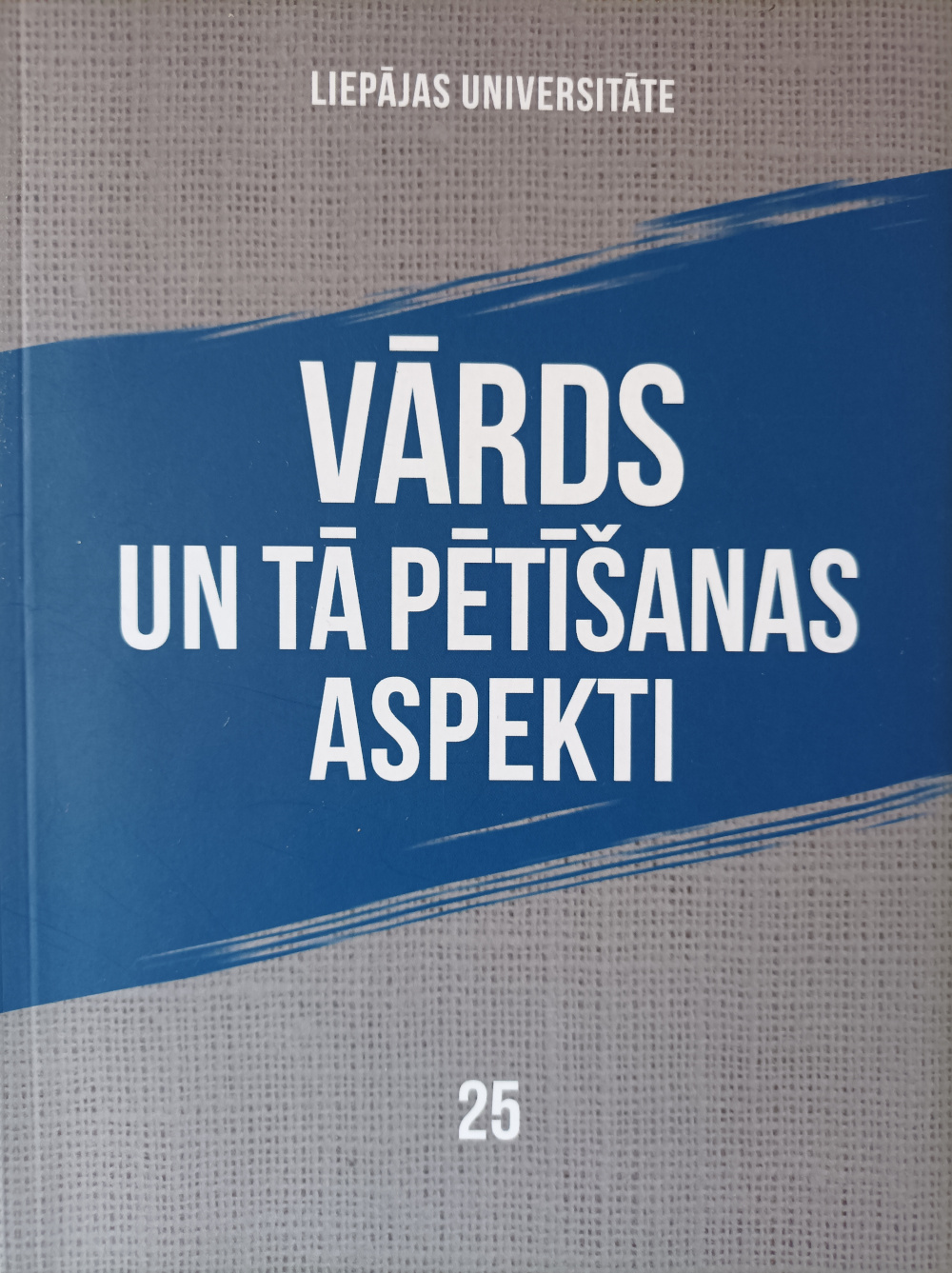
|
SATURS I daļa Fonētika, gramatika, leksika, stilistika Vārda diahroniskais un areālais aspekts |
|
|
|
Brigita Bušmane Dravanta, svilpene, circeņu zupa un citi putru resp. zupu nosaukumi latviešu valodas izloksnēs |
|
Anna Frīdenberga Pēda, pēdējs un pēdīgs 16. un 17. gadsimta rakstu avotos |
|
Daiki Horiguči Aizgūto pamatverbu un prefiksverbu lietojuma skaitliskās attiecības |
|
Ilga Jansone Silvijas Raģes (1928.2.XI–1976.20.VII) devums latviešu valodniecībā |
|
Agita Kazakeviča Divdabis un palīgteikums jeb plašākas konstrukcijas ar divdabi mūsdienu tekstos |
|
Iveta Kopankina Vadībzinātnes jomas zinātnisko tekstu ievaddaļu makrostruktūras un mikrostruktūras sākotnējās izpētes rezutāti |
|
Justīne Kuzņecova Leksēmas krāpt, krāpnieks un to sinonīmi latviešu tautasdziesmās |
|
Sintija Ķauķīte Abreviatūras publicistikā un interneta portālos |
|
Kristīne Levāne-Petrova Ciešamās kārtas tagadnes divdabju funkcionālā daudznozīmība |
|
Liene Markus-Narvila Ā-celma verbu vienskaitļa un daudzskaitļa 2. personas refleksīvās formas galotne: LVDA materiāli |
|
Rafael Martin Calvo Morphological Typology of Affixed Evaluative Forms in Spanish and Latvian |
|
Bronius Maskuliūnas Senųjų lietuviškų tekstų leksikos semantika: liežuvis ir kalba |
|
Ieva Ozola Lejaskurzemes izlokšņu aprakstos neminētie: daļēji lokāmie divdabji |
|
Sanda Rapa Vietvārda mūžs |
|
Anitra Roze Jaunvārdu atlases kritēriji „Mūsdienu latviešu valodas vārdnīcā” |
|
Anna Stafecka Dažas verba formu paralēles Latgalē un Lejaskurzemē |
|
Daiga Straupeniece Lingvistiskās īpatnības Būtiņģes un Sventājas teicējas XX gadsimta 60. gadu vēstulēs |
|
Agris Timuška Daži dialektāli graudkopības termini: ģeolingvistisks pārskats |
|
Anta Trumpa Daži īpatnēji negatīvu īpašību apzīmējumi Jaunās Derības latviešu tulkojumā (1685) |
|
Edita Valiuliene The Metaphoric Use of the English cool and its Cultural Background |
|
Daira Vēvere Patskaņu un divskaņu zuduma un ar to saistīto fonētisko pārveidojumu noturīgums dziļajās tāmnieku izloksnēs |
|
II daļa Valoda un vide |
|
Vineta Apse Problems in Tertiary Level Essays |
|
Ilze Auziņa Latviešu valodas apguvēju kļūdu analīze: pareizrakstības kļūdas |
|
Agata Babina Verba būt lietojums spāņu un latviešu valodā lingvodidaktiskiem mērķiem |
|
Agita Baltgalve Vārds kā simbols ķīniešu „Pārmaiņu grāmatā” |
|
Karolina Butkuvienė Identity Construction through Linguistic Means: Case studies of Young Adult Fiction |
|
Aina Būdvytytė Tėvas kaip pasaulio kategorizacijos atskaitos taškas lietuvių ir |
|
Agnese Dubova Sekundāro zinātnisko tekstu atlase un to makrostruktūras izpēte |
|
Andrejs Gorbunovs Bērnu tiesību valodas vēsturiskā attīstība Latvijas teritorijā: Ingars Gusāns |
|
Anita Helviga Vārda episks nozīmes transformācija mūsdienu latviešu valodā |
|
Larisa Iļjinska Pragmatic Adaptation within Cognitive Approach to Translation of Popular Science Texts |
|
Oksana Ivanova LSP Text Translation Teaching: Communicative Competence |
|
Inga Kaija Pretējā virziena valodas apguvēju tekstu analīze valodas apguvē |
|
Игopь Kopoлeв Moдycная opганизация дискурсивных практик национального кооперативного коммуникативного поведения украинцев, русских, литовцев и американцев (США) |
|
Nijolė Litevkienė Evolution of Lithuanian Anatomical Terominology: Anatomical Terms in Kazimieras Kuzavinis’ Dictionary Lotynų-Lietuvių kalbų žodynas |
|
Vineta Poriņa Kritiskā incidenta metode Latvijas sabiedrības divvalodības pētniecībā |
|
Valda Rudziša Juridisko pamatterminu glosārijs līgumtiesībās Latvijā izdoto nozarvārdnīcu kontekstā |
|
Jānis Sīlis Intertekstualitāte kanoniska oriģināldarba interpretācijā netradicionālā angļu avottekstā un tā latviešu tulkojumā |
|
Haтaлия Cтeфaнoвa Meтодическая процедура приминения сопоставительно-параметрического метода для анализа сем оценочно-маркированных слов англ. good / укр. добрий-добро |
|
Solveiga Sušinskienė Nominalizations as Cohesive Devices in Mass Media Texts |
|
Silga Sviķe „Jaunās botāniskās vārdnīcas” mikrostruktūra: tradicionālais, mainīgais, inovatīvais |
|
Ilze Štrausa Kāpēc tevi tā sauc? |
|
Daiva Šveikauskienė Lietuvių kalbos žodžių kompiuterinis kodavimas |
